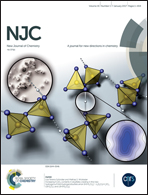Increasing H2SO4 contents in disulfates cresting in the new hydrogenium-bis-hydrogendisulfate anion [H(HS2O7)2]−: Li2[S2O7]·H2SO4, Li[HS2O7], and Li[H(HS2O7)2]
Abstract
The reactions of simple Li salts like sulfates, carbonates, and chlorides with fuming sulfuric acid or neat SO3 led to a couple of new acidic Li disulfates with varying H2SO4 : SO3 ratios, namely Li2[S2O7]·H2SO4 (orthorhombic, Pca21, Z = 4, a = 945.67(8) pm, b = 485.77(4) pm, c = 1793.9(1) pm, V = 824.1(1) × 106 pm3, R1 (all data) = 0.138, wR2 (all data) = 0.0380), Li[HS2O7] (monoclinic, Cc, Z = 4, a = 685.87(3) pm, b = 788.49(4) pm, c = 911.48(5) pm, β = 101.618(2)°, V = 482.83(4) × 106 pm3, R1 (all data) = 0.148, wR2 (all data) = 0.0416), and Li[H(HS2O7)2] (monoclinic, P21/n, Z = 2, a = 498.69(2) pm, b = 808.57(3) pm, c = 1297.22(5) pm, β = 94.875(2)°, V = 521.18(3) × 106 pm3, R1 (all data) = 0.157, wR2 (all data) = 0.0481). The stamping structural feature of these salts are moderate and strong hydrogen bonds linking the anions to chains and layers. Especially for Li[H(HS2O7)2] a very strong symmetrical hydrogen bond is found linking two hydrogendisulfate anions via a common hydrogen atom to the new hydrogenium-bis-hydrogendisulfate anion [H(HS2O7)2]−.
![Graphical abstract: Increasing H2SO4 contents in disulfates cresting in the new hydrogenium-bis-hydrogendisulfate anion [H(HS2O7)2]−: Li2[S2O7]·H2SO4, Li[HS2O7], and Li[H(HS2O7)2]](/en/Image/Get?imageInfo.ImageType=GA&imageInfo.ImageIdentifier.ManuscriptID=C6NJ02388F&imageInfo.ImageIdentifier.Year=2017)

 Please wait while we load your content...
Please wait while we load your content...